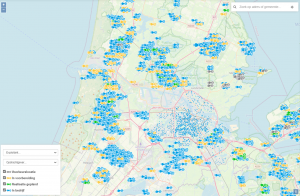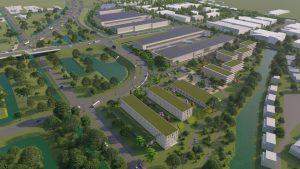Stadslogistiek: Kan de metropool de lading dekken?
In grote delen van de Metropoolregio Amsterdam mogen straks alleen nog maar zero-emissie voertuigen rondrijden. Werken aan een goede laadinfrastructuur rondom logistieke hubs, distributiecentra en op regionale bedrijventerreinen is daarom cruciaal. Bij de zevende meetup over de Green Deal ZES zagen we wat er al gebeurt, maar ook welke uitdagingen er nog liggen. “Stroom is niet het probleem, de capaciteit is dat wel.”
Verladers, transporteurs en logistiek dienstverleners worden nu gestimuleerd om over te stappen naar schone, elektrische transportvoertuigen. “We moeten dus ook gaan investeren in een regionale aanpak voor slimme laadmogelijkheden”, zegt Richard Hoving, Lead Mobiliteit bij de Amsterdam Economic Board bij de start van de meetup. “We kunnen deze gigantische opgave namelijk alleen aan als we hier samen aan werken.”
Megawatt charging
Robert van den Hoed kent de uitdagingen als geen ander. Hij is voorzitter van de werkgroep logistiek van de Nationale Agenda Laadinfrastructuur, die onder meer een kennis- en actieagenda ontwikkelt, onderzoek doet, tools en handreikingen publiceert en nationale initiatieven aanjaagt. Het uitgangspunt? Ervoor zorgen dat de logistieke laadinfrastructuur geen belemmering vormt voor de nulemissielogistiek.
Voor het laden van bestelbussen en straks ook vrachtwagens is immers veel meer vermogen nodig. Er wordt zelfs al aan megawatt charging gewerkt. “Een trekkeroplegger moet soms ook onderweg kunnen laden en dat kan niet bij Fastned, we hebben hier dus aparte snellaadinfra voor nodig”, zegt Van den Hoed. “En denk bijvoorbeeld aan bouwlocaties. Als we daar ook willen gaan laden hebben we een vervroegde netaansluiting nodig.”
Van de 1 miljoen bestel- en vrachtvoertuigen is nu nog slechts 0,6 procent elektrisch en E-Laad NL verwacht dat er in 2025 al zo’n 40.000 elektrische bestel- en vrachtvoertuigen zijn en 600.000 in 2035. Aanjagers voor verdere groei zijn de zero-emissie zones, maar ook het gegeven dat er steeds meer elektrische alternatieven beschikbaar komen. Van den Hoed: “Ook de prijzen van batterijen gaan nog steeds hard omlaag: de Total Cost of Ownership van elektrische bestelbussen is nu nog duurder, maar dat duurt niet lang meer. En voor vrachtwagens gaat straks hetzelfde gelden .”
De werkgroep logistiek van de Nationale Agenda Laadinfrastructuur organiseert op 14 oktober een evenement over dit onderwerp. Hier vind je meer informatie.
De regionale laadbehoefte in beeld
Voor Maarten Linnenkamp, programmamanager MRA-Elektrisch is de grootste uitdaging om de laadbehoefte goed in beeld te krijgen. Hoeveel bedrijven hebben er (snel)laadcapaciteit nodig? Moet dat publieke of private laadcapaciteit zijn? “Als we dit weten kunnen we dit matchen met het netbeheer en kunnen we op tijd de juiste voorzieningen treffen. Vooral de capaciteit die netbeheerders bieden is zorgelijk; we kunnen niet zomaar overal laadpalen neerzetten.”
Het uitgangspunt van MRA-Elektrisch is dat de regio zo efficiënt mogelijk omgaat met de energie die er is. “Dat is een enorme opgave, ook omdat alle huizen van het gas af moeten en dat ook bedrijven als Tata Steel meer elektrisch gaan doen. Tegelijkertijd moet het niet zo zijn dat als iemand nu een snellader installeert hij ervoor zorgt dat zijn buurman dat straks niet meer kan doen. Daarom is het zo belangrijk dat we alles op een knappe kaart inzichtelijk maken.”
Stroom is het nieuwe goud
Volgens Walther Ploos van Amstel, Lector City Logistics aan de Hogeschool van Amsterdam is stroom het nieuwe goud. Tegelijkertijd zien veel mensen nadenken over de laadinfrastructuur als corvee. Slimme marktpartijen spelen daarop in door met dure oplossingen te komen. Zijn advies? Laat je de caas — charging as a service — niet van het brood eten en besteed aandacht aan je eigen laadprofiel.
Lees hier de hele column van Walther.
Logistieke proeftuin CLIC
CLIC kan een belangrijke bijdrage leveren aan onze logistieke laaduitdaging. CLIC staat voor City Logistics Innovation Campus en is een gebied van 132.000m2 langs de A9 dat vanaf eind 2022 als proeftuin gaat dienen voor energie in de stadslogistiek. “Wij zien CLIC als een city port, waar goederenstromen binnenkomen die daar overgeslagen worden, waardoor er ook allerlei andere services nodig zijn”, zo vertelt projectmanager Robert Kreeft.
Uitvinden, uitproberen en uitrollen staan er centraal. Er wordt gezocht naar mogelijkheden om de energietoevoer te variëren, bijvoorbeeld met een buffer in de vorm van een wadi , een virtual power plant. “Door de capaciteit van bijvoorbeeld koelhuizen en foodbereiding in te zetten kunnen we tot een lagere vermogensvraag komen”, zegt Kreeft. “Dan hebben we een lagere centrale aansluiting nodig en hoeft de netbeheerder dus minder te investeren. We hebben ook data nodig over vertrek- en aankomsttijden van voertuigen. Zo weten we op welke momenten en op welke plaatsen we buffers moeten creëren.”
Een belangrijk uitgangspunt van de experimenten is dat er een businessmodel komt waarin alle deelnemende partijen profiteren. Kreeft: “Alleen dan creëer je een win-win-winsituatie.”
In de wachtkamer
Pallas Agterberg, Challenge Officer bij Alliander neemt ons mee in het capaciteitsvraagstuk. De stroom gaat niet op, legt ze uit. We produceren zelf meer dan genoeg en hebben een goede aansluiting met andere landen. De grote uitdaging is de capaciteit van ons netwerk. “In de Metropoolregio zijn behoorlijk wat congestiegebieden, wat betekent dat de wachtkamer al vol is. Daarnaast hebben we de komende jaren 3 tot 4,5 keer zoveel netwerk nodig, dus de wachttijden zullen oplopen.”
Alliander werkt eraan om de vraag voor de korte en middellange termijn scherper te krijgen en zoekt naar gebieden waar nog capaciteit is. Ook wil het bedrijf de realisatie van meer laadcapaciteit versnellen door doorlooptijden te verkorten en meer technici te werven. Ook het anders gebruiken van aansluitingen, bijvoorbeeld met opslag, wordt onderzocht.
Agterberg: “We kunnen hier alleen samen aan werken. Je gaat geen dure elektrische vrachtwagen kopen als je niet kunt laden. Als er geen locatie bekend is, ga je niet met de laadinfrastructuur aan de slag. We moeten dus op zoek naar doorbraken als we niet in die wachtkamer willen blijven zitten wachten.”
Bestaande bedrijventerreinen
Wat kunnen we op de bestaande bedrijventerreinen al doen?, vraagt Hoving aan het einde van de bijeenkomst aan de sprekers van vandaag. Volgens Ploos van Amstel moet er op bestaande bedrijventerreinen vooral geschakeld worden met de eigenaren van de panden. “Zij hebben vaak meerdere panden in zo’n gebied en een plan voor verdere ontwikkeling. We moeten hen dus om de tafel krijgen.” Linnenkamp van MRA-Elektrisch moedigt aan om per gebied goed in beeld te krijgen wat er al is, wat er kan en wat er mag. “We moeten soms gewoon beginnen, gewoon doen.” Van der Hoed verwijst naar de bussector die een goede methodiek heeft voor het vaststellen van goede logistieke punten.
“Vandaag werd duidelijk dat er nieuwe verbindingen nodig zijn”, besluit Hoving de bijeenkomst. “De discussie is nog lang niet af en u vraagt wij draaien bestaat niet. We moeten dus samen blijven werken op de route naar de zero-emissie gebieden in 2025.”
Op 12 oktober is er een nieuwe meetup over de greendeal ZES. Wil je ondertussen meer weten over elektrisch rijden in de stadslogistiek? Op ons Insights-platform vind je een Quick Start die je op weg helpt.
23 juni 2021
Meer weten over
Neem contact op
Blijf jij ook op de hoogte?
8x per jaar nieuws en events uit de regio: schrijf je in voor de Board Update nieuwsbrief
Deel dit artikel
Wil je op de hoogte blijven?
Volg ons dagelijks op LinkedIn en schrijf je in voor de Board Update nieuwsbrief.
Lees ook deze berichten
- Met de selectie van vier kanshebbers is de regionale voorronde van de ...
- Met meer dan 80 ondernemers, 40 investeerders en diverse dienstverleners bood LSH Capital Match ...
- In tijden van geopolitieke spanningen, technologische revoluties en politieke onzekerheden is het ...



